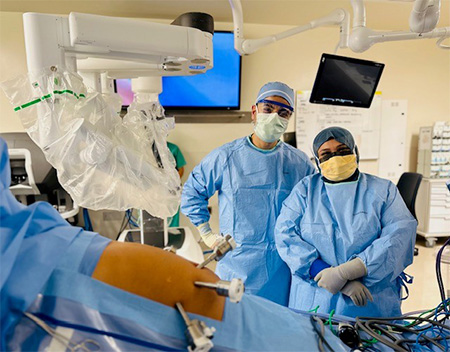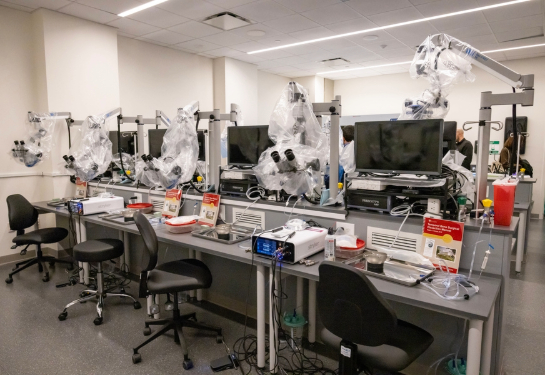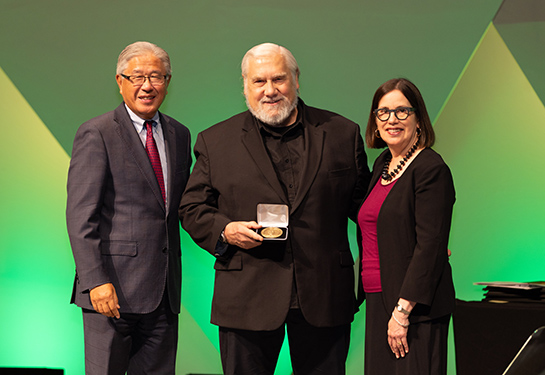Robotic-assisted surgery for children now offered at UC Davis Children’s Hospital
A Q&A with pediatric general surgeon Payam Saadai
Pediatric general surgeon Payam Saadai directs the pediatric robotic-assisted surgery program, which is now available at the UC Davis Children’s Surgery Center. For the past year, he worked with the adult robotic surgery team to expand this minimally invasive approach to pediatric patients in the Sacramento region. Now he trains pediatric surgeons to use the robot. We asked him some questions about the program, its potential and where he sees the future of robotic-assisted surgery.
What are the benefits of robotic-assisted surgery for children?

Robotic surgery is widely accepted and available for adults who need general surgical procedures. However, it has not been widely adopted in pediatric surgery, except for the field of pediatric urology. Like traditional laparoscopic surgery, robotic surgery offers the same benefits of a minimally invasive approach including reduced pain and discomfort, faster recovery time, minimal scarring and a shorter stay in the hospital. It also confers a degree of visualization and depth that traditional laparoscopy lacks as well as improved instrument articulation. The robot also has very advanced technological components such as an embedded optic technology that can allow us to see structures such as blood vessels and bile ducts better during the surgery. It also provides significant advantages to the surgeon in terms of ergonomics and occupational health.
Can you contrast the difference between traditional and robotic surgical approaches?
Traditional minimally invasive surgery is laparoscopic surgery. It uses instruments that are directly controlled by the surgeon's hand in a linear plane and using a two-dimensional camera. The surgeon is limited by both internal anatomical structures, such as the bony pelvis, as well as external barriers such as the operating room table. In contrast, robotic surgery uses very advanced technology to allow the surgeon to operate more flexible instruments in many different planes and using a three-dimensional camera. We do this still from inside the operating room so that we are next to the patient, but we are not so close that we may be limited by external barriers.
What robot is used?
We use the Da Vinci Xi System. It can do the fine suturing that is needed in pediatric surgery. It can work in deep spaces and around corners. There’s also a 360-degree ability to rotate instruments so you can be in all the directions that you need to be. The robot can also get under bony structures and work upside down in ways that you can’t in traditional surgery.
What types of procedures are suitable for taking a robotic approach?
Many traditional general surgical procedures may work for a robotic approach. These include straightforward surgeries such gallbladder removals (cholecystectomies), spleen removals (splenectomies), surgery to treat stomach acid reflux (fundoplications) and intestinal surgery, as well as more complex surgeries such as excision of a choledochal cyst, liver resections and pancreatic surgery.
The ideal application of the robot is in areas of the body where it has traditionally been difficult to reach with conventional open surgery or even laparoscopy. As an example, the deep pelvis is an area where the robot is very useful as it allows us to finely dissect and suture with excellent visualization, which it can be very difficult with traditional approaches. This is of particular interest to me given my specialty in pediatric colorectal disease.
How do patient families respond to the prospect of robotic surgery?
Many patient families like the idea of using leading-edge technology for procedures and want to understand more about it. There is the misconception that the robot or that artificial intelligence is doing the surgery, but we let them know that the surgeon is still doing the operation. Robotic-assisted surgery just provides us with another tool, another approach.
Is this a first for UC Davis Health or our service area?
Yes, for pediatric general surgery, as far as I know.
Tell us about the first pediatric general surgery case involving the robot at UC Davis Health.
Like many new and exciting things, this was partly by chance and partly by our department having the right elements in place at the perfect time. I had a pediatric patient who needed his gallbladder out, and he had previously undergone a type of bariatric surgery. I consulted Dr. Shushmita Ahmed, who is an expert in bariatric surgery, and we decided this patient would be better served from a robotic approach. I was previously trained in robotic-assisted surgery during my pediatric surgery fellowship, but I had not performed any robotic-assisted procedures at UC Davis. Dr. Ahmed offered her collaboration and her experience with performing robotic surgeries at UC Davis to help us perform our first pediatric robotic-assisted procedure in the Department of Surgery.
Where do you see pediatric robotic surgery in the future?
The technology is changing, and changing fast. I believe that with continued improvements in the size of the instrumentation that is used for robotic surgery, we will be able to use the robotic approach for more delicate congenital procedures in infants and very young children. It is only a matter of time.
Learn more about pediatric gastroenterology at UC Davis Children’s Hospital.





